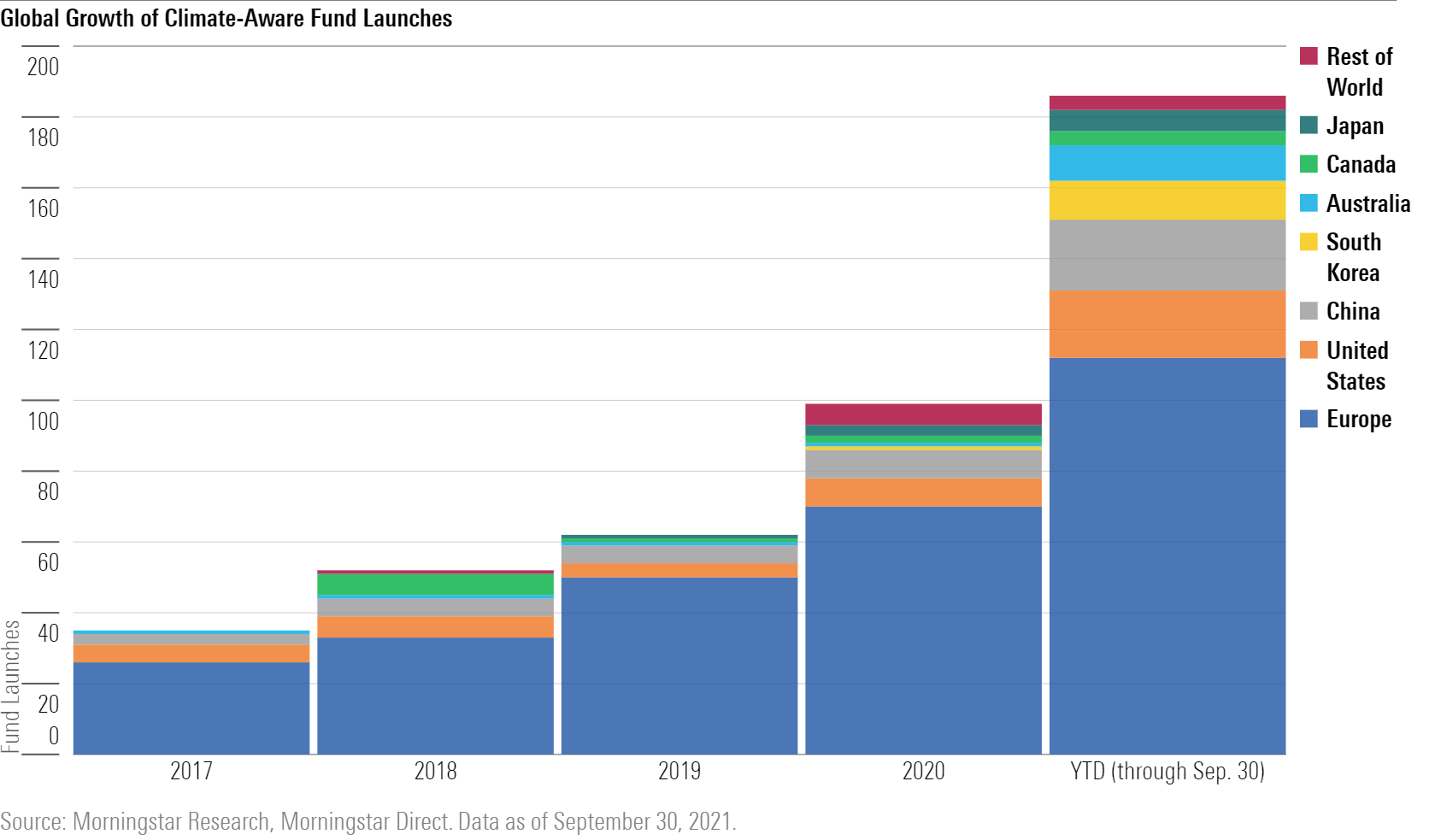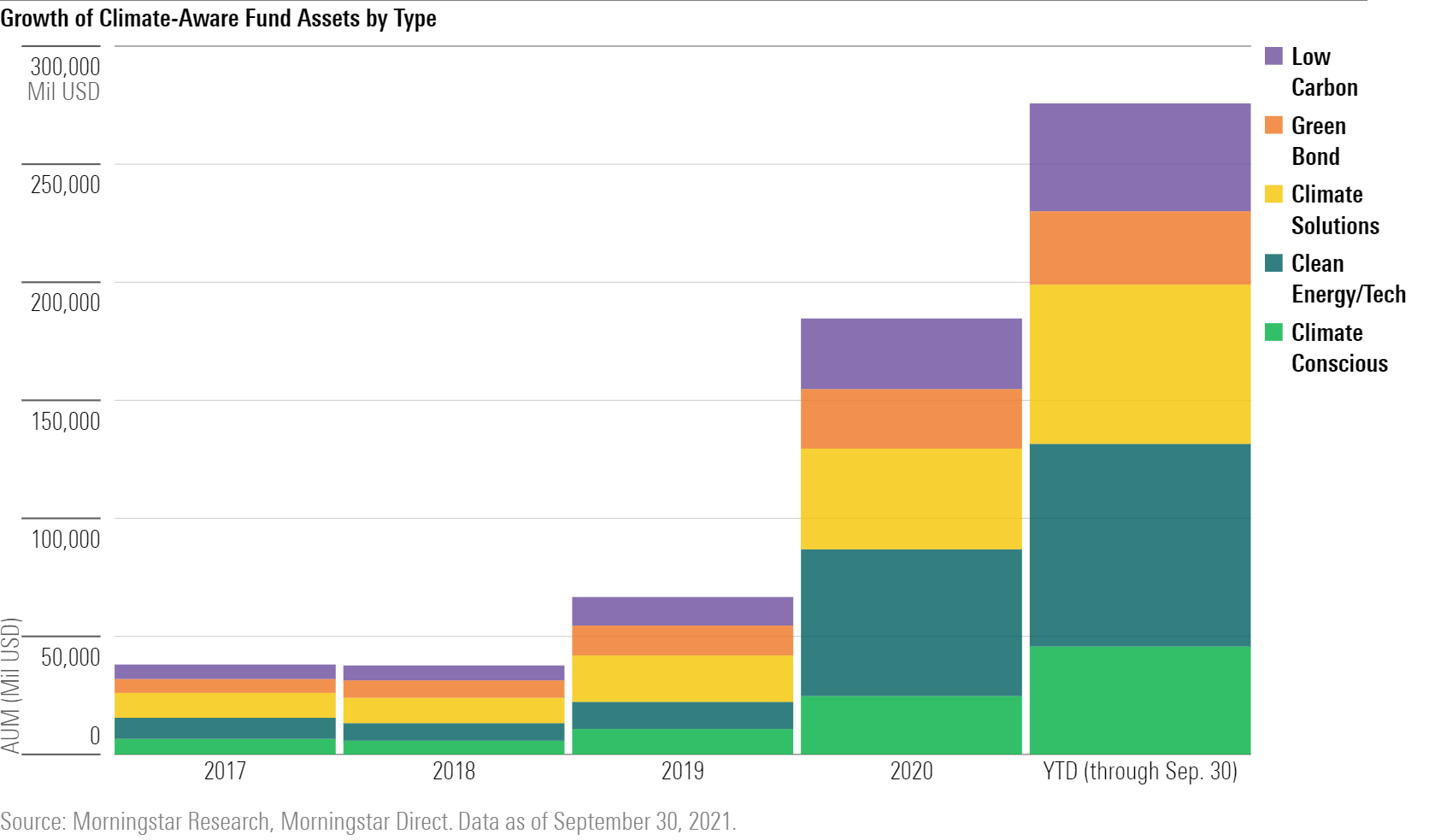How Can You Invest in Climate Funds?
Uncover what climate solutions can fit into your portfolio.

The upcoming COP26 meetings in Glasgow will cast a spotlight on how the world is addressing the climate crisis. As part of an all-hands-on-deck global effort to achieve net zero greenhouse gas emissions as quickly as possible, as much as $173 trillion of investment capital needs to be directed into climate solutions.
Mark Carney, special UN envoy for climate action and former Bank of England governor, calls the move to net zero the "greatest commercial opportunity of our time." Investors also need to take steps to protect their portfolios from climate risks: Some investments will be disadvantaged in the transition to net zero, while others will find themselves vulnerable to physical risks from extreme events caused by climate change. By some estimates, the global economy could be as much as 14%, or $23 trillion, smaller in 2050 than it otherwise would be if climate change continues unabated.
Fund investors have a burgeoning number of choices to invest in climate-change-related opportunities, as well as to mitigate climate risk in their portfolios. In this article, portions of which were published earlier this year, we sort out the climate-focused fund landscape to help investors navigate what can be a confusing mix of offerings as they seek to decarbonize their investments and help finance the transition to a low-carbon economy.
2021 Sees Record Growth of Climate Funds
A record number of climate-aware funds have launched for the year to date through September. These 186 new funds bring the total number of climate funds to 636 globally. Assets in climate funds have increased by 50% so far in 2021 to reach $275 billion.
Unsurprisingly given its greater commitment to a climate agenda, Europe registered the highest growth, with 112 new climate fund launches. Europe remains by far the largest and most diverse universe, with a total of 434 climate products representing $216 billion in assets.
The United States remains the second-largest climate fund market, with close to $29 billion in assets and 19 new climate fund launches this year. However, China is catching up, having seen 20 new climate products hit the shelves this year and the overall market accounting for $26.1 billion.


A Range of Approaches to Climate Solutions
While our focus here is on climate-aware funds--those that specifically focus on climate risks and opportunities--keep in mind that they comprise a subset of the even larger sustainable funds universe, which is also experiencing rapid growth globally.
Virtually all diversified sustainable funds are also climate-aware, but they consider a broader range of material environmental, social, and governance issues and impact metrics in addition to those related to climate change.
Climate-aware funds span a range of approaches that can be organized into five types:
- Low-carbon funds seek to invest in companies with reduced carbon intensity and/or to construct their portfolios to have a lower carbon footprint relative to a benchmark index. Some of these funds completely exclude investments in fossil-fuels companies or activities. These typically well-diversified funds attempt to mitigate exposure to climate risk and can be used to gain broad equity exposure.
- Climate-conscious funds select or tilt their portfolios toward companies that consider climate change in their business strategy and therefore are better firms for the transition to a low-carbon economy. Some of them may exclude companies involved in the fossil-fuels industry, but most would consider including fossil-fuels companies that are transitioning their businesses to low-carbon activities. Like low-carbon funds, climate-conscious funds are typically well-diversified and can be used to gain broad equity exposure. These funds may be a means to reduce climate risk, as well as to invest in companies that may benefit from the transition to a low-carbon economy.
- Climate-solutions funds specifically target companies benefiting from products and services that contribute to the low-carbon transition. These thematic funds are less diversified than their climate-aware or climate-conscious counterparts, and are often overweight in smaller companies in the industrials and technology sectors. Because of that, climate-solutions funds should represent smaller allocations to the equity portion of most investors' portfolios.
- Clean-energy/tech funds are more focused than climate-solutions funds, investing in firms that specifically contribute to or facilitate the clean energy transition. Most of these companies are in the utilities, industrials, and tech sectors, many of them smaller enterprises. Essentially quasi-sector funds, clean-energy/tech funds should represent smaller allocations to the equity portion of most investors' portfolios.
- Green-bond funds invest in debt instruments that finance projects facilitating the transition to a green economy. Most green-bond funds maintain credit quality and interest-rate sensitivity similar to those of intermediate-bond funds. Investors can also gain exposure to green bonds via sustainable bond funds.
So far in 2021, asset managers, particularly in Europe, have focused their product development efforts on climate-conscious funds, which represented a third of all climate fund launches, followed by clean-energy/tech funds (27%) and climate-solutions funds (19%).
Clean-energy/tech funds and climate-solutions funds remain the most popular types globally, accounting for 31% and 25%, respectively, of all climate fund assets.


The graphic below summarizes the different approaches of climate-aware funds.

Which Climate Funds Are Right for You?
The choice of one type over another largely depends on an investor's investment goals, risk appetite, and preferences. For example:
- Investors who are concerned about the risks to their investments posed by climate change can look to low-carbon funds to decarbonize their portfolio. These vehicles are primarily oriented toward mitigating climate-related risks. Our analysis shows that these approaches provide broad and diversified exposure to the market and are therefore suitable as a core portfolio allocation.
- Investors who are concerned about climate-related risks and want to invest in opportunities that may benefit from the transition to a low-carbon economy can turn to climate-conscious funds. They typically exhibit low carbon risk and low fossil-fuels exposure, with the added benefit of higher carbon solutions involvement. Most of these climate funds provide sufficiently diversified exposure to the market to be suitable as a core allocation. Many sustainable funds that have broader ESG mandates may be similarly suitable choices.
- Investors who want to direct capital to climate-change solutions can look to climate-solutions and clean-energy/tech strategies. Because of their narrower market exposure and bias toward mid-caps and small caps, these funds represent more-volatile investments. They are more suitable as part of a satellite allocation to complement rather than replace existing core holdings.
- Investors who want to orient their fixed-income exposure toward climate solutions may find green-bond funds a good fit. Investors should be aware that the projects financed by green bonds are indeed providing green solutions, but green-bond issuers may be heavy carbon emitters that are transitioning to a lower-carbon activities. Many sustainable bond funds with broader ESG mandates include green bonds in their portfolios.
Climate-aware investors can also take an all-of-the-above approach. To address climate risk in core equity holdings, investors can use low-carbon or climate-conscious funds or opt for more broadly based sustainable funds with low-carbon or climate-conscious features. They can make green bonds a central part of their fixed-income exposure, either via dedicated green-bond funds or more broadly based sustainable bond funds that invest a portion of their portfolios in green bonds. And they can dedicate a portion of their investments to climate-solutions or clean-energy/tech funds as a way to help finance the transition to net zero.
As COP26 dominates the news in the coming days, it will likely spark even more investor interest in addressing climate change in their portfolios, both to mitigate climate risk and to invest in climate solutions. With so many climate-aware fund options, understanding the range of strategies is an important first step in positioning portfolios to align with net zero goals.
The author or authors do not own shares in any securities mentioned in this article. Find out about Morningstar’s editorial policies.

/s3.amazonaws.com/arc-authors/morningstar/42c1ea94-d6c0-4bf1-a767-7f56026627df.jpg)

/cloudfront-us-east-1.images.arcpublishing.com/morningstar/6NPXWNF2RNA7ZGPY5VF7JT4YC4.png)
/cloudfront-us-east-1.images.arcpublishing.com/morningstar/RYIQ2SKRKNCENPDOV5MK5TH5NY.jpg)
/cloudfront-us-east-1.images.arcpublishing.com/morningstar/6ZMXY4RCRNEADPDWYQVTTWALWM.jpg)
:quality(80)/s3.amazonaws.com/arc-authors/morningstar/42c1ea94-d6c0-4bf1-a767-7f56026627df.jpg)